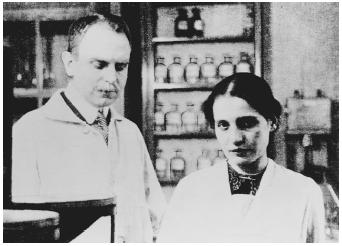Lise Meitner
AUSTRIAN PHYSICIST
1878–1968
On any list of scientists who should have won a Nobel Prize but did not, Lise Meitner's name would be near the top. She was the physicist who first realized that the atomic nucleus could be split to form pairs of other atomic nuclei—the process of nuclear fission . Although she received many honors for her work, the greatest of all was to elude her because of the unprofessional conduct of her colleague Otto Hahn.
Born in Vienna, Meitner decided early on that she had a passion for physics. At that time, education for female children in the Austro-Hungarian Empire terminated at fourteen, as it was argued that girls did not need any more education than that to become a proper wife and mother. Willing to support his daughter's aspirations, her father paid for private tutoring so she could cover in two years the eight years of education normally needed for university entrance. In 1901 Meitner was one of only four women admitted to the University of Vienna, and in 1905 she graduated with a Ph.D. in physics.
As a student, Meitner had become fascinated with the new science of radioactivity, but she realized that she would have to travel to a foreign country to pursue her dream of working in this field. She applied for work with Marie Curie, but was rejected. However, she did eventually receive an offer from the University of Berlin, which had just hired a young scientist by

the name of Otto Hahn. Having a chemical background, Hahn was looking for a collaborator with a theoretical physics background. Unfortunately, the chemistry institute at the university was run by Emil Fischer who had banned women from the institute's premises. Reluctantly, Fischer agreed to let Meitner work in a small basement room. During this time, she received no salary and relied on her family for enough money to cover her living expenses. Meitner and Hahn's research during this time period resulted in the discovery of the element protactinium.
The post–World War I government in Germany was much more favorable to women, and Meitner became the first woman to serve as a physics professor in that country. By the 1930s scientists were bombarding heavy elements with neutrons and it was claimed that new superheavy elements formed as a result of this process. Using such a procedure, Meitner and Hahn thought they had discovered nine new elements. Meitner was puzzled by all the new elements for which claims were made.
Unfortunately, the Nazi Party's rise to power changed everything for Meitner. Because she was a Jew by birth, although a later convert to Christianity, Meitner's situation became increasingly precarious. With help from a Dutch scientist, Dirk Coster, she escaped across the German border into Holland and then made her way to Stockholm, where the director of the Nobel Institute for Experimental Physics reluctantly offered her a position. Stockholm had one advantage for Meitner, an overnight mail service to Germany so she could keep in regular contact with Hahn.
On December 19, 1938, Hahn sent Meitner a letter describing how one of the new elements had chemical properties strongly resembling those of barium and asking if she could provide an explanation. The physicist Otto Frisch visited Meitner, his aunt, for Christmas to help dispel her loneliness. While there, the two went for the now famous "walk in the snow." During an extended conversation in the woods, they came to realize that if the nucleus was considered a liquid drop, the impact of a subatomic particle could cause the atom to fission. If so, it was possible that the barium-like element was actually barium itself.
Meitner immediately contacted Hahn and his colleague Fritz Strassmann. Through experiment they confirmed that the so-called new element was indeed barium. They reported their discovery of nuclear fission to the world's scientific press, barely mentioning the names of Meitner and Frisch. In fact, Hahn never admitted that it was Meitner who had made the critical conceptual breakthrough. In 1944 Hahn was awarded the Nobel Prize in chemistry for his contribution to the discovery of nuclear fission.
Although nominated several times, Meitner never did receive the Nobel Prize for physics that many scientists considered her due. Only now, with element 109 having been named Meitnerium (symbol Mt) has she finally received some recognition for her crucial work. Meitner retired to England where she died at the age of eighty-nine.
SEE ALSO Barium ; Curie, Marie Sklodowska ; Fischer, Emil Hermann ; Nuclear Fission ; Protactinium ; Radiation .
Marelene Rayner-Canham
Geoffrey W. Rayner-Canham
Bibliography
McGrayne, Sharon Bertsch (1993). Nobel Prize Women in Science: Their Lives, Struggles and Momentous Discoveries. New York: Birch Lane Press.
Rayner-Canham, Marelene, and Rayner-Canham, Geoffrey (1998). Women in Chemistry: Their Changing Roles from Alchemical Times to the Mid-Twentieth Century. Washington, DC: American Chemical Society and the Chemical Heritage Foundation.
Sime, Ruth Lewin (1996). Lise Meitner: A Life in Physics. Berkeley: University of California Press.
Internet Resources
"Lise Meitner Online." Available from http://www.users.bigpond.com/Sinclair/fission/LiseMeitner.html .
Comment about this article, ask questions, or add new information about this topic: